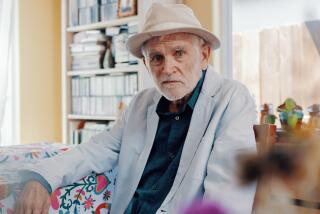Waiting for the Big One, That’s So L.A.
- Share via
If you’re looking for a symbol of how earthquakes continue to confound us, you need go no further than Vladimir Keilis-Borok. A few weeks ago, the UCLA seismologist predicted a Southern California temblor of magnitude 6.4 or greater between now and Sept. 5. Like any good scientist, Keilis-Borok hedged his bet, giving the quake a 50% chance of occurring within a 12,000-square-mile swath of desert, a set of parameters so vast that it represents a prediction in name alone. Even so, he has lots of people chattering about the San Andreas and the Big One, not least because a similar Keilis-Borok forecast, issued last June, appears to have accurately called the 6.5 earthquake that struck the Central Coast near San Simeon on Dec. 22.
No one has heard more of the chatter than Lucy Jones at the U.S. Geological Survey’s Pasadena office. “I don’t think it helps that this telephone game is going on,” sighs Jones, whose mantra is “You can’t know exactly when and where, so get prepared.”
Keilis-Borok’s forecast, she says, is less a prediction than a scientific hypothesis. His team has identified certain factors that appear to function as quake precursors, a theory they need to hone. In Southern California though, with its anxious media and public, it’s hard to make distinctions between theory and fact.
Jones, one of the smartest seismologists working, hammers away on a telling point: As a practical matter, this forecast is so broad as to be useless. On a metaphoric level, however, the prediction has a bit more value, especially given the arrival Sunday of the NBC miniseries “10.5.”
In this computer-enhanced tale, a series of killer quakes ripple down the West Coast from Seattle, turning Los Angeles into an island after much of the rest of California falls into the sea. “The Big One is only the beginning,” blares the network promo, as the Golden Gate slides into oblivion. This taps into the same elemental mix of fear and anticipation that has made prediction such a fascination for so long.
The destruction of California, after all, is one of the enduring tropes of disaster fantasy, from Myron Brinig’s 1933 novel “The Flutter of an Eyelid,” which ends with Southern California toboganning into the Pacific, to John Carpenter’s movie “Escape From L.A.,” which features another seismic stranding of L.A. So Keilis-Borok and the producers of “10.5” are operating in the shadow of a grander catastrophe, the sine qua non of destruction, the moment when all of us here in California finally get our comeuppance for -- whatever it is we need comeuppance for.
There is, of course, a major fault line of difference between Keilis-Borok’s hypothesis and the fictional earthquake swarm suggested by “10.5.” One involves sober science, while the other traffics in absurdity.
There is compelling evidence that a great quake struck the Pacific Northwest on Jan. 26, 1700, causing tsunamis to sweep across the Pacific to Japan. It has been estimated at magnitude 9.0, and scientists believe that is the biggest temblor anyone in the continental United States is ever likely to see. Besides, not even the most disastrous earthquake could send California tumbling into the ocean. Tectonic plates may shift, but they don’t turn to dust and dissolve in salt water.
Still, science isn’t totally absent from the TV hype. The idea of earthquake interaction is valid: Many seismologists believe that temblors “talk” to one another, with the release of energy from one quake “loading” or stressing the next section of fault.
This way of seeing earthquakes as a continuum motivates “10.5” as well as the work of Keilis-Borok, who regards seismicity as a regional phenomenon, in which small tremors set the stage for more devastating events. Ultimately, however, I can’t help thinking that there’s a more important link here, one that has less to do with science and the mechanics of earthquakes than with psychology -- the irresolvable dilemma of living in a disaster zone. At the deepest level, both Keilis-Borok and “10.5” speak to our uncertainties and resonate with our most primal fears.
To know when and where a quake is coming would be to gain a measure of protection, just as we may be reassured by imagining a catastrophe so big it could never happen, against which reality pales.
What better way of grappling with the future than to name the unnamable, to conceive the inconceivable? It’s talismanic, a strategy for focusing our anxiety. And it allows us to believe, for a moment, that we have mastered the elemental forces that hold us in their sway.
More to Read
Sign up for Essential California
The most important California stories and recommendations in your inbox every morning.
You may occasionally receive promotional content from the Los Angeles Times.











